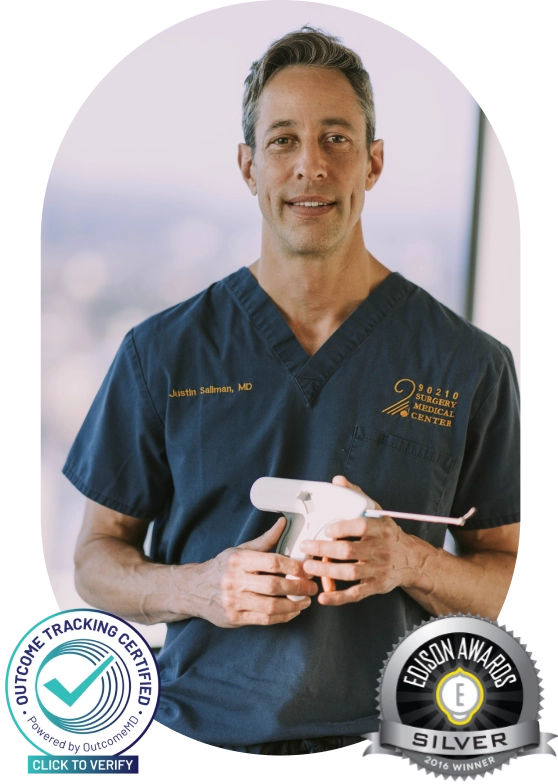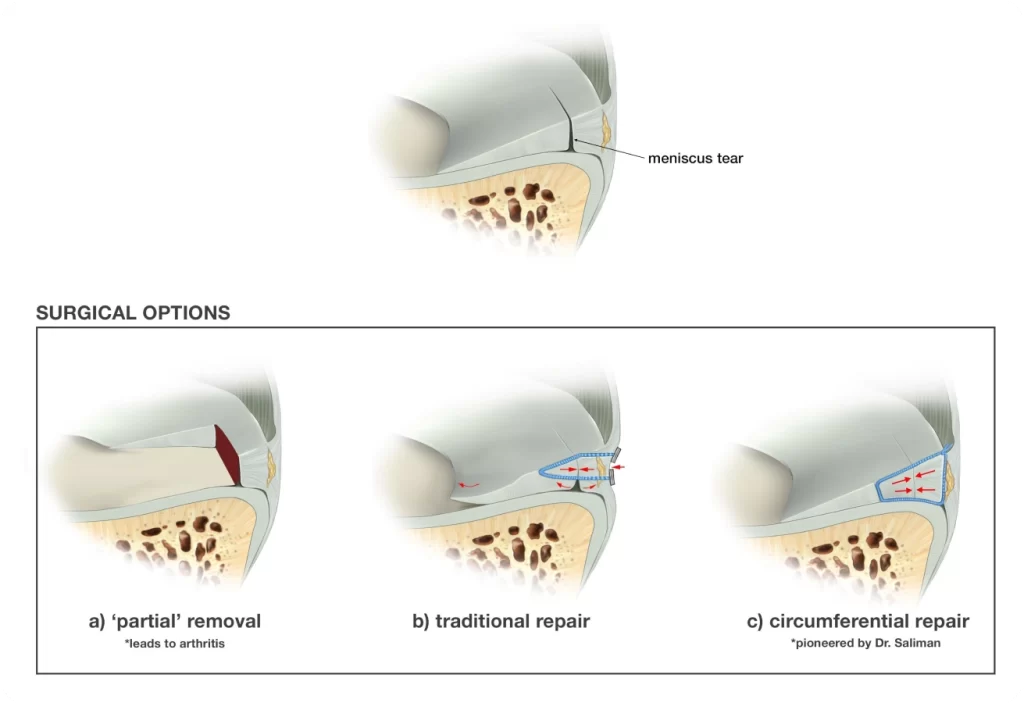Have your meniscus tear repaired by the
Bucket Handle Meniscus Tear Specialist

Have a bucket handle meniscus tear?
Don’t let someone remove your meniscus.
SAVE YOUR MENISCUS! Living with a meniscus tear or allowing a surgeon to remove the torn parts significantly increases your risk for arthritis and knee replacement. Anterior horn tears commonly cause pain in the front of the knee and are often ignored or removed by doctors. Don’t let someone “trim”, “debride” or “clean up” your meniscus or temporarily mitigate your symptoms with cortisone, PRP or stem cells. Have it sewn back together by the best! Justin D. Saliman, MD invented the Circumferential Stitch for meniscus repair which is ideal for anterior horn tears. Nobody has more experience passing this revolutionary stitch!
Why repair a bucket handle meniscus tear?
And why with the Circumferential Stitch?
Meniscus repair has been around a long time, but traditional techniques have had somewhat high failure rates and were only possible for a limited number of tear types. The meniscus spreads forces evenly within the knee joint, and, without its full function, the knee becomes arthritic.

Why are Circumferential Stitches important for bucket handle meniscus tears?
- Lines up the tear edges up perfectly and uniformly compress them together during the 6 weeks it takes for the meniscus to heal
- Repairs the top and bottom of the bucket handle tear at the same time (traditional repair was only practical on the top side and surgeons typically ignored the bottom side which leads to partial healing and eventual re-tearing of the meniscus)
- Does not entrap the capsule during sewing which may allow more natural movement of the repaired meniscus (other techniques can pull the repaired meniscus partially out of the joint)
- The needle used in NovoStitch device is tiny and it cuts in-line with the circumferential fibers of the meniscus. Other techniques have left large holes which can propagate new tears
- Passing the circumferential stitch does not require needle passes in the direction of the neurovascular structures
- There is no other device that can safely and reliably pass circumferential stitches in all zones of the meniscus

Am I too old to have my meniscus repaired?
NO! Studies have shown that patient age is not a factor, and that the meniscus can heal in patients of all ages provided the knee is not already arthritic
I was told my bucket handle tear was probably in the area that did not have a good blood supply hence would be unlikely to heal?
Traditional techniques inadequately approximated the torn edges, leading to poor healing. Surgeons often blame the blood supply even though there is excellent medical literature evidence that the avascular zones heal if adequately held together during the healing process.
Why repair your meniscus? Read:
“The Circumferential Compression Stitch for Meniscus Repair”
What is a bucket handle meniscus tear?
Bucket handle meniscus tears are serious injuries to the meniscus in which the meniscus rips away from its attachments in the back of the knee (the posterior horn) and flips forward into the front of the knee (like folding a pancake in half). Many surgeons will simply remove the torn flipped fragment, but without the full function of your meniscus, your knee joint becomes arthritic. This has been definitively proven in the medical literature. And the only definitive treatment for an arthritic knee is total knee replacement – so, SAVE YOUR MENISCUS!
Symptoms of a bucket handle meniscus tear may include one or more of the following:
- Pain
- Inability to fully straighten your knee
- Swelling
- Feeling as though your knee is catching
- Locking or buckling
- Instability in your knee
You may still be able to walk after you tear your meniscus, and in fact, many athletes continue to play with a meniscal tear. With bucket handle tears the meniscus can flip back into place and feel good for some time, but it will typically flip back forward with one wrong painful move.
How are bucket handle meniscal tears treated?
Leaving bucket handle meniscus tear within your knee will likely cause intermittent locking of your knee, and increases your risk of arthritis and the eventual need for knee replacement surgery. Similarly, removal of the torn parts (often called “trimming” or “partial meniscectomy”) also results in significantly reduced effectiveness of your meniscus resulting in arthritis. Injecting the knee with cortisone, PRP or even stem cells, has not been shown to heal bucket handle meniscus tears. There are simply too many knee forces on a bucket handle tear constantly pulling it apart, hence it cannot heal well without stitches holding the tear in place to resist those forces during the 6 weeks that it takes for the tear to heal (similar to a cast for a broken bone).
Your best option is to have your bucketed fragment sewn back to the remnant where it was previously attached rather than simply removed. However, traditional meniscus repair techniques only worked for a fraction of these tears, hence most orthopaedic surgeons have unfortunately embraced meniscus removal surgery. But now there’s a new option – THE CIRCUMFERENTIAL STITCH! This stitch anatomically aligns the tear edges and uniformly compresses them together during the healing process in a way never before possible. This is the secret sauce that Dr. Saliman brought to the world. Bucket handle tears, in particular, are perfect for Circumferential Stitch repair, which can restore the anatomical orientation of a bucket handle tear as it sews the edges cleanly back together and incorporates both the top and bottom of the tear.
What is the NovoStitch Pro Meniscal
Repair System?
Dr. Saliman invented the NovoStitch Pro Meniscal Repair System in 2008 and then founded the start-up Ceterix® Orthopaedics in 2010 to develop the technology. The NovoStitch was approved by the FDA in 2012, received a Silver Award in the 2015 Edison Awards in the surgical tools category, and was recently purchased by a well known medical device company called Smith & Nephew.
Dr. Saliman uses his NovoStitch device to place circumferential compression stitches around meniscus tears to hold the torn edges together during healing. There is no need for removal of the tissue, which has been shown to increase the risk of future knee problems. Nobody has more experience sewing meniscus tears back together with circumferential stitches than Dr. Saliman.
For the best care of your meniscal tear from the inventor of the procedure that sews your meniscus with Circumferential Stitches, call the office of Justin D. Saliman, MD, or request an appointment online today.


“This is a great honor for our founder, Dr. Justin Saliman, and our R&D team,” said John McCutcheon, president and CEO. “We are pleased to be included with the great innovators recognized by the Edison Awards.”
Justin Saliman, Founder and Chief Medical Officer at Ceterix said: “We are excited by the growth opportunities of the NovoStitch Pro at Smith & Nephew and are proud of the impact our technology has made in developing the meniscal repair market.”
Privacy Policy | Terms & Conditions | Accessibility | Notice | Contact Us
Justin D. Saliman, MD, Los Angeles, CA
Phone (appointments):(310)703-5819
Phone (general inquiries):(310)703-5819
Address: 8436 W 3rd St, Suite 800,
Los Angeles, CA 90048
Justin D. Saliman, MD, Beverly Hills, CA
Phone (appointments):(310)703-5819
Phone (general inquiries): (310)703-5819
Address: 450 N. Roxbury Dr. , Ste 600, Beverly Hills, CA 90201

